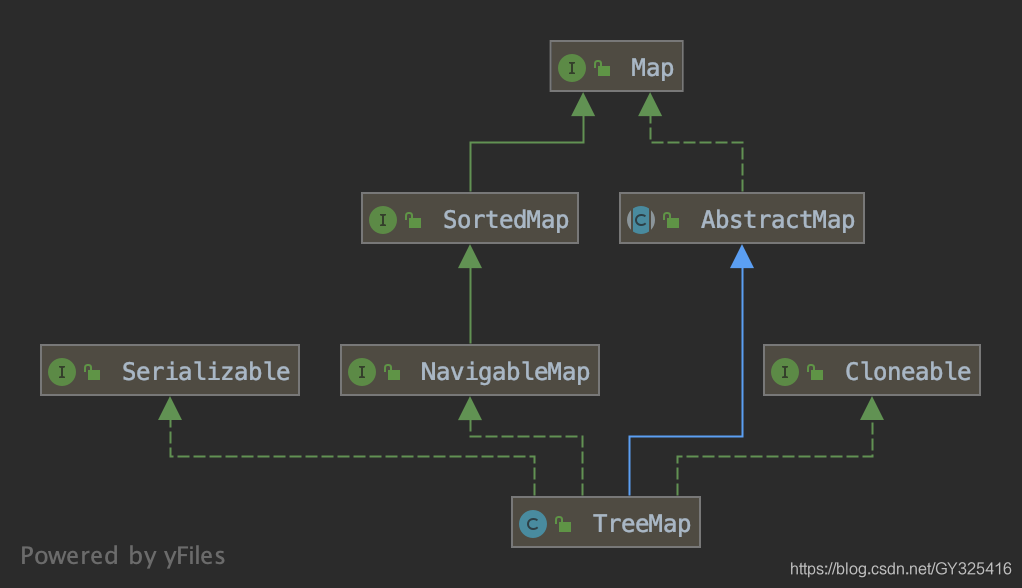简介
基于红黑树的实现,根据key的自然顺序排序,或者根据构造方法传入的排序方式。
类继承关系

属性
//构造方法传入的比较器 借此维护键的顺序
private final Comparator<? super K> comparator;
private transient Entry<K,V> root;//根节点
private transient int size = 0;//长度
private transient int modCount = 0;//修改次数
构造方法
//构造一个空的map,使用键的自然排序
public TreeMap() {
comparator = null;
}
public TreeMap(Comparator<? super K> comparator) {
this.comparator = comparator;
}
public TreeMap(Map<? extends K, ? extends V> m) {
comparator = null;
putAll(m);
}
public TreeMap(SortedMap<K, ? extends V> m) {
comparator = m.comparator();
try {
buildFromSorted(m.size(), m.entrySet().iterator(), null, null);
} catch (java.io.IOException cannotHappen) {
} catch (ClassNotFoundException cannotHappen) {
}
}
内部类
//红黑树
static final class Entry<K,V> implements Map.Entry<K,V> {
K key;
V value;
Entry<K,V> left;
Entry<K,V> right;
Entry<K,V> parent;
boolean color = BLACK;
Entry(K key, V value, Entry<K,V> parent) {
this.key = key;
this.value = value;
this.parent = parent;
}
}
添加put
public V put(K key, V value) {
Entry<K,V>t = root;
if (t == null) {//如果根节点为null 将当前节点设置根
root = new Entry<>(key, value, null);
size = 1;
modCount++;
return null;
}
int cmp;
Entry<K,V> parent;
// 根据比较器获得父节点和比较路径
Comparator<? super K> cpr = comparator;
//如果为空 使用key自然排序
if (cpr != null) {
do {
parent = t;
cmp = cpr.compare(key, t.key);
if (cmp < 0)
t = t.left;
else if (cmp > 0)
t = t.right;
else
return t.setValue(value);
} while (t != null);
}
//使用比较器 找到父节点
else {
if (key == null)
throw new NullPointerException();
@SuppressWarnings("unchecked")
Comparable<? super K> k = (Comparable<? super K>) key;
do {
parent = t;
cmp = k.compareTo(t.key);
if (cmp < 0)
t = t.left;
else if (cmp > 0)
t = t.right;
else
return t.setValue(value);
} while (t != null);
}
//构造新节点 根据比较器结果判断 左右节点
Entry<K,V> e = new Entry<>(key, value, parent);
if (cmp < 0)
parent.left = e;
else
parent.right = e;
fixAfterInsertion(e);//插入后修正红黑树
size++;
modCount++;
return null;
}
获取get
public V get(Object key) {
Entry<K,V> p = getEntry(key);
return (p==null ? null : p.value);
}
//使用比较器找到可以所在节点
final Entry<K,V> getEntry(Object key) {
if (comparator != null)
return getEntryUsingComparator(key);
if (key == null)
throw new NullPointerException();
Comparable<? super K> k = (Comparable<? super K>) key;
Entry<K,V> p = root;
while (p != null) {
int cmp = k.compareTo(p.key);
if (cmp < 0)
p = p.left;
else if (cmp > 0)
p = p.right;
else
return p;
}
return null;
}
final Entry<K,V> getEntryUsingComparator(Object key) {
K k = (K) key;
Comparator<? super K> cpr = comparator;
if (cpr != null) {
Entry<K,V> p = root;
while (p != null) {
int cmp = cpr.compare(k, p.key);
if (cmp < 0)
p = p.left;
else if (cmp > 0)
p = p.right;
else
return p;
}
}
return null;
}
删除remove
public V remove(Object key) {
Entry<K,V> p = getEntry(key);//先查出数据
if (p == null)
return null;
V oldValue = p.value;
deleteEntry(p);
return oldValue;
}
private void deleteEntry(Entry<K,V> p) {
modCount++;
size--;
// 将下一个节点放到p位置
if (p.left != null && p.right != null) {
Entry<K,V> s = successor(p);
p.key = s.key;
p.value = s.value;
p = s;
} // p has 2 children
// 修复节点
Entry<K,V> replacement = (p.left != null ? p.left : p.right);
if (replacement != null) {
// 链接替换到父级
replacement.parent = p.parent;
if (p.parent == null)
root = replacement;
else if (p == p.parent.left)
p.parent.left = replacement;
else
p.parent.right = replacement;
p.left = p.right = p.parent = null;
// Fix replacement
if (p.color == BLACK)
fixAfterDeletion(replacement);
} else if (p.parent == null) { // 如果只有一个节点,则返回
root = null;
} else { // 没有子节点。使用self作为幻像替换并取消链接。
if (p.color == BLACK)
fixAfterDeletion(p);
if (p.parent != null) {
if (p == p.parent.left)
p.parent.left = null;
else if (p == p.parent.right)
p.parent.right = null;
p.parent = null;
}
}
}
总结
TreeMap内部是红黑树
如果不自定义排序,那么就使用key的自然排序
可以存储null键和值